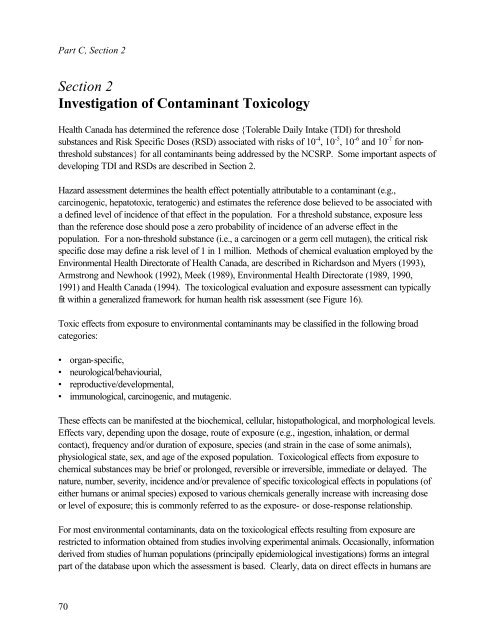Protocol for the Derivation of Environmental and Human ... - CCME
Protocol for the Derivation of Environmental and Human ... - CCME
Protocol for the Derivation of Environmental and Human ... - CCME
Create successful ePaper yourself
Turn your PDF publications into a flip-book with our unique Google optimized e-Paper software.
Part C, Section 2<br />
Section 2<br />
Investigation <strong>of</strong> Contaminant Toxicology<br />
Health Canada has determined <strong>the</strong> reference dose {Tolerable Daily Intake (TDI) <strong>for</strong> threshold<br />
substances <strong>and</strong> Risk Specific Doses (RSD) associated with risks <strong>of</strong> 10 -4 , 10 -5 , 10 -6 <strong>and</strong> 10 -7 <strong>for</strong> nonthreshold<br />
substances} <strong>for</strong> all contaminants being addressed by <strong>the</strong> NCSRP. Some important aspects <strong>of</strong><br />
developing TDI <strong>and</strong> RSDs are described in Section 2.<br />
Hazard assessment determines <strong>the</strong> health effect potentially attributable to a contaminant (e.g.,<br />
carcinogenic, hepatotoxic, teratogenic) <strong>and</strong> estimates <strong>the</strong> reference dose believed to be associated with<br />
a defined level <strong>of</strong> incidence <strong>of</strong> that effect in <strong>the</strong> population. For a threshold substance, exposure less<br />
than <strong>the</strong> reference dose should pose a zero probability <strong>of</strong> incidence <strong>of</strong> an adverse effect in <strong>the</strong><br />
population. For a non-threshold substance (i.e., a carcinogen or a germ cell mutagen), <strong>the</strong> critical risk<br />
specific dose may define a risk level <strong>of</strong> 1 in 1 million. Methods <strong>of</strong> chemical evaluation employed by <strong>the</strong><br />
<strong>Environmental</strong> Health Directorate <strong>of</strong> Health Canada, are described in Richardson <strong>and</strong> Myers (1993),<br />
Armstrong <strong>and</strong> Newhook (1992), Meek (1989), <strong>Environmental</strong> Health Directorate (1989, 1990,<br />
1991) <strong>and</strong> Health Canada (1994). The toxicological evaluation <strong>and</strong> exposure assessment can typically<br />
fit within a generalized framework <strong>for</strong> human health risk assessment (see Figure 16).<br />
Toxic effects from exposure to environmental contaminants may be classified in <strong>the</strong> following broad<br />
categories:<br />
• organ-specific,<br />
• neurological/behaviourial,<br />
• reproductive/developmental,<br />
• immunological, carcinogenic, <strong>and</strong> mutagenic.<br />
These effects can be manifested at <strong>the</strong> biochemical, cellular, histopathological, <strong>and</strong> morphological levels.<br />
Effects vary, depending upon <strong>the</strong> dosage, route <strong>of</strong> exposure (e.g., ingestion, inhalation, or dermal<br />
contact), frequency <strong>and</strong>/or duration <strong>of</strong> exposure, species (<strong>and</strong> strain in <strong>the</strong> case <strong>of</strong> some animals),<br />
physiological state, sex, <strong>and</strong> age <strong>of</strong> <strong>the</strong> exposed population. Toxicological effects from exposure to<br />
chemical substances may be brief or prolonged, reversible or irreversible, immediate or delayed. The<br />
nature, number, severity, incidence <strong>and</strong>/or prevalence <strong>of</strong> specific toxicological effects in populations (<strong>of</strong><br />
ei<strong>the</strong>r humans or animal species) exposed to various chemicals generally increase with increasing dose<br />
or level <strong>of</strong> exposure; this is commonly referred to as <strong>the</strong> exposure- or dose-response relationship.<br />
For most environmental contaminants, data on <strong>the</strong> toxicological effects resulting from exposure are<br />
restricted to in<strong>for</strong>mation obtained from studies involving experimental animals. Occasionally, in<strong>for</strong>mation<br />
derived from studies <strong>of</strong> human populations (principally epidemiological investigations) <strong>for</strong>ms an integral<br />
part <strong>of</strong> <strong>the</strong> database upon which <strong>the</strong> assessment is based. Clearly, data on direct effects in humans are<br />
70
















